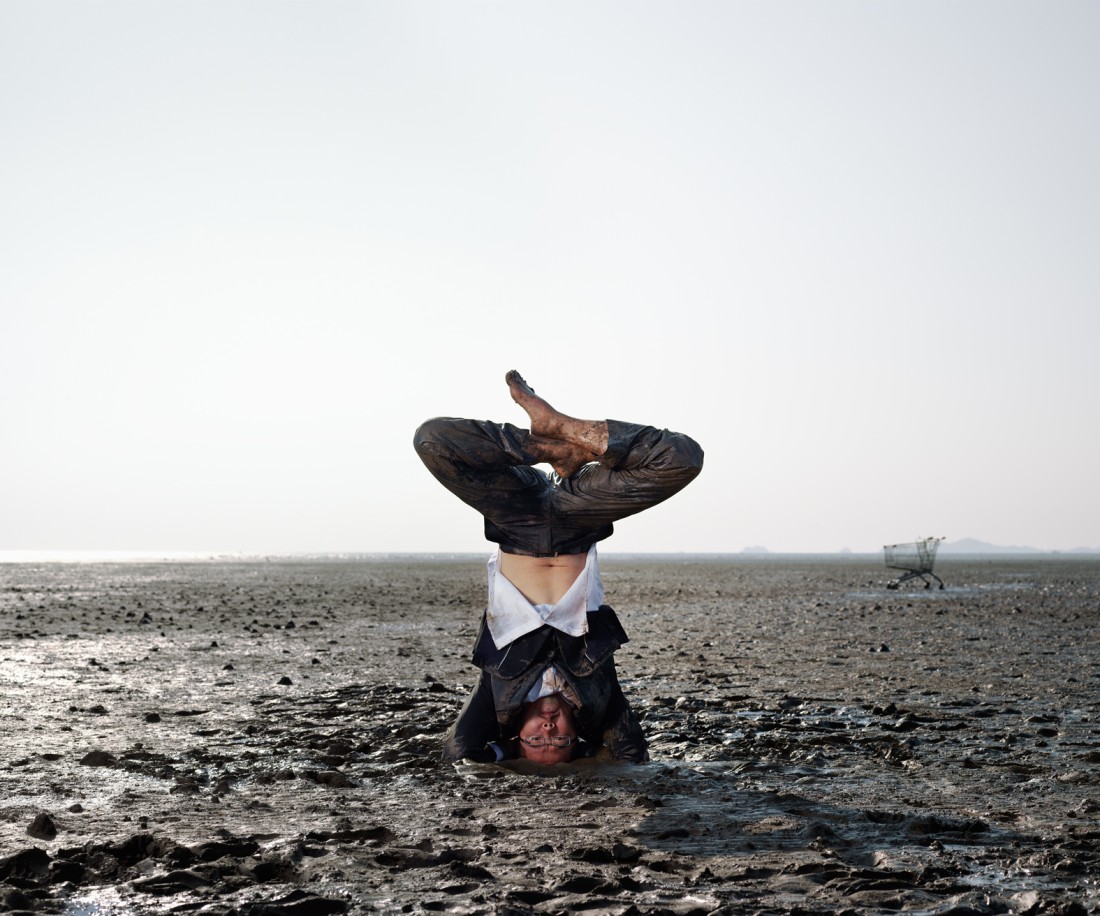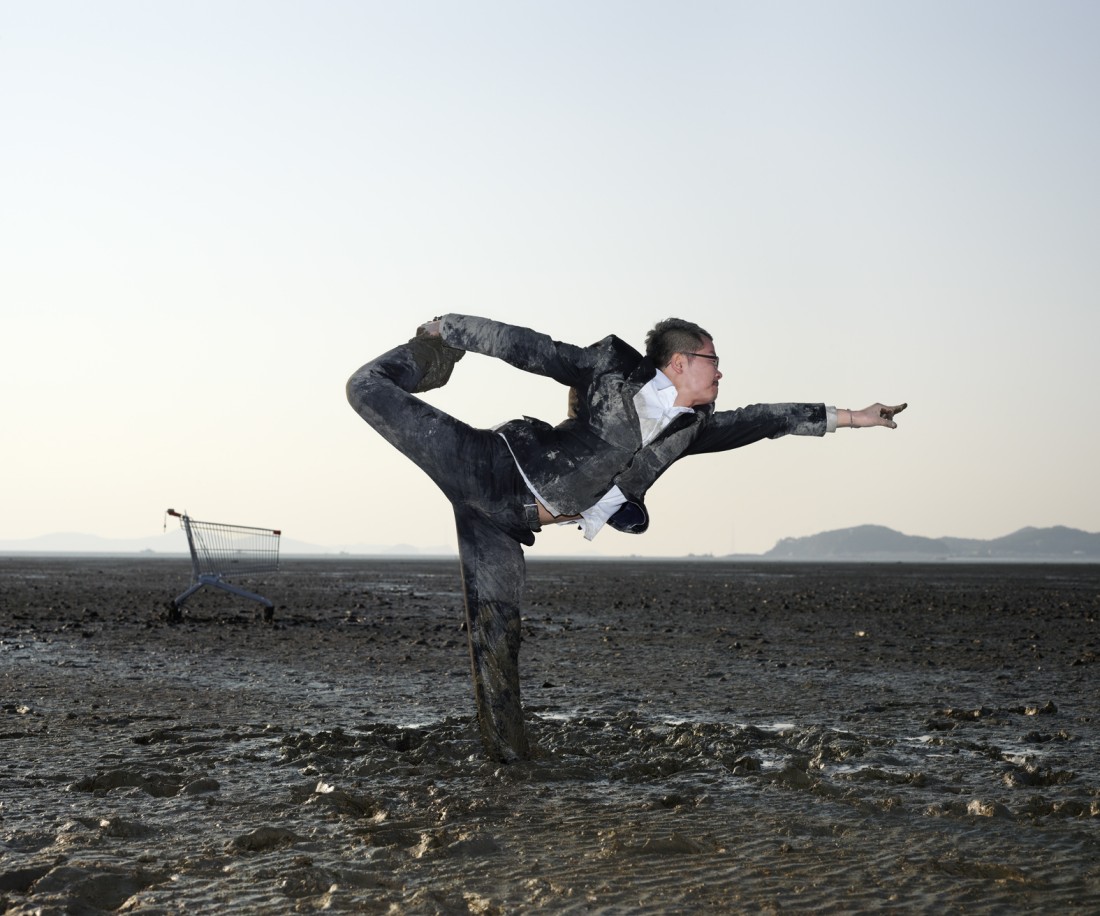Yoga Project
Yoga project (2011~2013)
Jungho Oak recently played on a mud flat. He did yoga and photographed himself doing yoga in the tidal flat of Ganghwa Island. What he did on a mud flat, yoga, was a playing. There's no other meaning than entertaining himself. It doesn't really matter if it is a satire on society, non-satire, a metaphor, a symbol nor even nothing. There are many ways for interpret about it, but the closest and the most literal one may be a playing on a mud flat or in-the-mud as he expressed. He said that he suddenly hit on the idea of doing yoga on a mud flat while drinking with his friend in the daytime. The mud flat isn't simple mud. It's like a pit sinking into gradually. If one stands on a mud flat, it feels like being landed on a hard ground at first, then the feeling changes as sinking into the sand. There's such sense of that a feet gets stuck in there. In fact, it's all depends on how much water or the sea covers an area of flat muddy land.
Of course, doing yoga or stretching on a mud flat rarely happens. Because it's not appropriate. Well, there are some exceptions to such venue being chosen; training for the marine corps, adventure entertainment programs on TV or experiencing army life. The mud flats are vital places for food production as well as for children's entertainment. They are important inhabits for a wide range of invertebrates from lugworms to cockles, a sheltered nature for turkeys and saltwort and a back yard playground for children grown up nearby. I remember my childhood experiences spending lots of time on the mud flats of the West Sea, swimming in the sea, rolling and sliding in the mud, building sand castles, stemming the tide and catching baby mullets and short necked clams.
Jungho Oak did yoga in his previous series of <Anyang Rainbow>. Doing yoga, to him, was a kind of a linguistic expression or a symbolic sign. The signs drawn by his physical body were there for laughing at varied situations of the society, just like a sarcastic smile. His physical gestures were placed in the solemn political and capital spots, such as Gwanghwamun, Anyang Stream and Tienanmen Square. He stood out of those places and led our eyes to look at them again. This style of his art has continued with his installations, performances and photographs of the places where the desire of our society is sensitively revealed. His yoga on a mud flat is an extension of his continuous artistic performance. However, the new series is slightly different. The difference initiates from the characteristics of chosen places and the performance he did in this time.
Unlike the former places, the mud flat points out a different characteristic of his art world. The mud flat is the natural place where the hands of men can hardly reach out and stays out from any symbols of the politics and the capital. It's a place signifying both original production and primitive power. Therefore, the mud flat takes its meaning as primitivism rather than having an artificial symbol. There is the indifference of nature to human that does not attempt to neither conquer nor being invaded. In the natural world, the human body purely and simply becomes a living thing composed of weight and volume. Jungho Oak did yoga on a mud flat as a living thing rather than as a man.
This does not mean that there is the purity of being-for-itself. The fact that the mud flat is regarded as a nature reserve and the nature itself is the symbol and sign of his artistic choice. He also brought a familiar sign into his photographic frames, a shopping cart used in large grocery markets and malls which is placed as if it's dumped on a mud flat. The shopping cart reminds us of a series of meanings, such as the market, consuming, the capital and New Liberalism. But it's just an empty cart and useless object on a mud flat which consequently puts the situation being humorous. A metal cart with four wheels runs well on a hard and flat ground, but turns out to be an useless load on a mud flat. Here, the end meets with the accordance in a rhetoric sense, because his yoga is also useless motion as a man's body is nothing special but a burden to the nature.
The artist says that he rather tried to focus on the realization and actualization of photography and remove meanings as much as possible. He precisely wanted to say nothing or emphasized on the trace and posture of his physical body on a mud flat without any symbolic signs. So his yoga posture becomes a lingual sign as well as the most pure form of human body. This is a possible antinomic state, because yoga itself has a cultural code pursuing at the concentration over the actions of human body. Indian yoga might started to look back on one's physical self, life and world throughout unordinary physical training and meditation. In such a notion, the mud flat actually very well fit into the original yoga practice. The scenery of which an artist wearing a suit does yoga on a mud flat, literally means such saying, "Dog fight in mud(이전투구 泥田鬪狗)“
–HongGu Kang (artist)
Supported Headstand Pose- Salamba Shirshasana, Archival Pigment Print, 145*174cm, 2011
Standing Bow Pulling Pose- Dandayamana Dhanurasana, Archival Pigment Print, 127*152cm, 2011
One-Legged King Pigeon Pose- Pada Rajakapotasana, Archival Pigment Print, 127*152cm, 2011
Supported Armstand Pose- Shirshasana, Archival Pigment Print, 127*152cm, 2011
Extended Triangle Pose- Utthita Trionasana, Archival Pigment Print, 127*152cm, 2011
Standing Forward Bend Pose- Uttansana, Archival Pigment Print, 127*152cm, 2011
Plough Pose– Halasana, Archival Pigment Print, 127*152cm, 2011
Rest Pose, Archival Pigment Print, 127*152cm, 2011
The Sun Salutations-Surya Namaskar
Installation View, Leeum, Samsung Museum of Art , 2011
Salutations - Surya Namaskar, 4 channel video , 5`30``, 2012
Orthoptera pose - Salabhasana
Orthoptera pose - Salabhasana / single channel video / 4`34``, 2012
Tree Pose- Vrksasana single channel vide
Tree Pose- Vrksasana / single channel video / 4`00``, 2013











